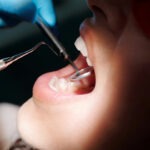 Most people have had at least one dental cavity in their lives. For many of these patients, the cavity did not result in any noticeable symptoms. In fact, in many cases, cavities are detected by dentists, highlighting the importance of routine dental exams. Indeed, by undergoing dental exams every six months, patients benefit from having dental problems caught in their earliest stages when they can be treated quickly and conservatively. At the practice of Steven Hochfelder, DMD, PA, we offer a range of restorative dentistry treatments to restore the health of the teeth, whether they are affected by small or large cavities. To find out which treatment for dental cavities is right for you, contact our Lake Mary, FL practice today.
Most people have had at least one dental cavity in their lives. For many of these patients, the cavity did not result in any noticeable symptoms. In fact, in many cases, cavities are detected by dentists, highlighting the importance of routine dental exams. Indeed, by undergoing dental exams every six months, patients benefit from having dental problems caught in their earliest stages when they can be treated quickly and conservatively. At the practice of Steven Hochfelder, DMD, PA, we offer a range of restorative dentistry treatments to restore the health of the teeth, whether they are affected by small or large cavities. To find out which treatment for dental cavities is right for you, contact our Lake Mary, FL practice today.
Administering Local Anesthetic for Your Comfort
When the dental cavity treatment process begins, we will administer a local anesthetic, such as Novocaine, to numb the hard and soft tissues surrounding the treatment area. First, we will apply a topical anesthetic to the Novocaine injection site. Then, we will gently inject the Novocaine into the treatment area. Over the next 10 to 15 minutes, the medication will completely numb the tooth and gums, preventing any discomfort during treatment.
Eliminating Tooth Decay
The next step in the treatment process is to remove any decayed or diseased tooth structure. This will prevent further infection, or decay, of the tooth.
To clean the tooth, we will use a dental drill to loosen all of the infected or decayed tooth structures. We will flush this debris out of the mouth using water spray and suction. When the tooth is clean and all signs of infection have been eliminated, we can move forward with the final step of treatment, restoring the tooth.
Restoring the Tooth
Because the cavity, or tooth decay, has created a hole in the tooth, the tooth needs to be restored to it original shape. By filling in the cavity, we can give the tooth the strength and support it needs to maintain its daily functions. Your restorative options include:
- Tooth-colored fillings: Tooth-colored fillings are the most common and conservative treatment option for cavities. This treatment is ideal for small cavities and involves the application of a composite resin material to fill in the cavity. The resin can be applied and hardened with a curing light. Additional layers of resin can be used to fill in the cavity and maintain the patient’s bite.
- Porcelain inlays and Onlays: If you have a moderately sized cavity on the biting surface of your posterior teeth, an inlay or onlay may be right for you. Inlays and onlays are made of dental porcelain and can be custom-made to restore your tooth. Inlays restore just the indented surface of the tooth, while onlays restore the indented surface and the cusps.
- Porcelain crowns: If you have a large cavity or underwent root canal therapy, a porcelain crown may be best suited to your needs. A crown completely encases a tooth, helping it to withstand the daily forces of biting and chewing.
To find out which treatment for dental cavities is right for you, contact the practice of Steven Hochfelder, DMD, PA.














